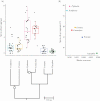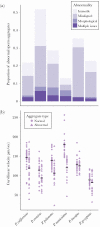Postcopulatory sexual selection is associated with sperm aggregate quality in Peromyscus mice
- PMID: 35210940
- PMCID: PMC8857933
- DOI: 10.1093/beheco/arab109
Postcopulatory sexual selection is associated with sperm aggregate quality in Peromyscus mice
Abstract
In some species, sperm form coordinated groups that are hypothesized to improve their swimming performance in competitive contexts or to navigate through the viscous fluids of the female reproductive tract. Here we investigate sperm aggregation across closely related species of Peromyscus mice that naturally vary by mating system to test the predictions that sperm aggregates 1) are faster than solitary sperm in species that females mate multiply to aid cells in sperm competition, and 2) outperform solitary sperm cells in viscous environments. We find significant variation in the size of sperm aggregates, which negatively associates with relative testis mass, a proxy for sperm competition risk, suggesting that postcopulatory sexual selection has a stabilizing effect on sperm group size. Moreover, our results show that sperm aggregates are faster than solitary sperm in some, but not all, species, and this can vary by fluid viscosity. Of the two species that produce the largest and most frequent groups, we find that sperm aggregates from the promiscuous P. maniculatus are faster than solitary sperm in every experimentally viscous environment but aggregation provides no such kinematic advantage under these same conditions for the monogamous P. polionotus. The reduced performance of P. polionotus aggregates is associated with less efficient aggregate geometry and the inclusion of immotile or morphological abnormal sperm. Our cross-species comparison yields insight into the evolution of sperm social behaviors, provides evidence of extensive variation in the Peromyscus lineage, and reveals that differences in sperm aggregate quality associate with postcopulatory sexual selection.
Keywords: mating systems; sexual selection; sperm competition; sperm conjugation; sperm motility.
© The Author(s) 2021. Published by Oxford University Press on behalf of the International Society for Behavioral Ecology. All rights reserved. For permissions, please e-mail: journals.permissions@oup.com.
Figures



Similar articles
-
The dynamics of sperm cooperation in a competitive environment.Proc Biol Sci. 2014 Sep 7;281(1790):20140296. doi: 10.1098/rspb.2014.0296. Proc Biol Sci. 2014. PMID: 25056618 Free PMC article.
-
Competition drives cooperation among closely related sperm of deer mice.Nature. 2010 Feb 11;463(7282):801-3. doi: 10.1038/nature08736. Epub 2010 Jan 20. Nature. 2010. PMID: 20090679 Free PMC article.
-
Apical Sperm Hook Morphology Is Linked to Sperm Swimming Performance and Sperm Aggregation in Peromyscus Mice.Cells. 2021 Sep 1;10(9):2279. doi: 10.3390/cells10092279. Cells. 2021. PMID: 34571928 Free PMC article.
-
Sexual selection and sperm diversity in primates.Mol Cell Endocrinol. 2020 Dec 1;518:110974. doi: 10.1016/j.mce.2020.110974. Epub 2020 Sep 12. Mol Cell Endocrinol. 2020. PMID: 32926966 Review.
-
An integrative view of sexual selection in Tribolium flour beetles.Biol Rev Camb Philos Soc. 2008 May;83(2):151-71. doi: 10.1111/j.1469-185X.2008.00037.x. Biol Rev Camb Philos Soc. 2008. PMID: 18429767 Review.
Cited by
-
The Known and Unknown About Female Reproductive Tract Mucus Rheological Properties.Bioessays. 2025 Jun;47(6):e70002. doi: 10.1002/bies.70002. Epub 2025 Mar 22. Bioessays. 2025. PMID: 40119784 Free PMC article. Review.
-
Bundle formation of sperm: Influence of environmental factors.Front Endocrinol (Lausanne). 2022 Oct 10;13:957684. doi: 10.3389/fendo.2022.957684. eCollection 2022. Front Endocrinol (Lausanne). 2022. PMID: 36299459 Free PMC article.
References
-
- Bates D, Mächler M, Bolker B, Walker S. 2015. Fitting linear mixed-effects models using lme4. J Stat Softw. 67:1–48.
Associated data
Grants and funding
LinkOut - more resources
Full Text Sources

